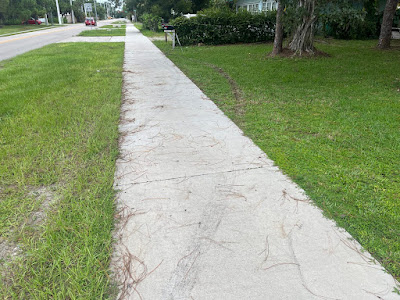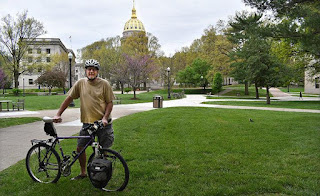Moreover, I have come to realize that you can tell what a person's status is, or was, in his or her community or society by the sort of penalty meted out to someone who commits a crime against, or otherwise causes harm to, that person.
Now, I'm not going to say "Don't get me started about drivers who get off scot-free when they run down cyclists!" because, well, I am going to rant about that, whether or not anybody gets me started.
Specifically, I am going to rant and rave about one particular cyclist who was so victimized. He has survived the ordeal, albeit with a fractured spine and deep bruises. He hopes to get back on his bike sooner rather than later, but he still faces a long recovery from the injuries he incurred a month ago today.
A 65-year-old motorist named Dennis Brophy, of Fort Pierce, Florida, was in the process of inhaling a "breathing treatment" when he drove his 2016 Chevy Cruze straight into the back of a cyclist who, like him, was traveling south on Old Dixie Highway. Brophy admitted he suffers from sleep apnea and said, according to the incident report, that he was "blinded by the light" and "never saw" the cyclist he struck.
That was at 8:03 am. The cyclist would spend the next two days in the Lawnwood Medical Center's ICU. Meantime, Brophy went home without even a citation for plowing into the cyclist, whom he could have just as easily killed.
 |
| Alan Snel, after a motorist struck him from behind |
That cyclist is Alan Snel. Perhaps you know him from reading his "Bicycle Stories" blog. You may also know, or know of, him from his extensive cycling advocacy, or from his work as a journalist in Nevada and Florida. It seems, though, that to Florida law enforcement officials, he was--as he says--"collateral damage", or simply someone who got in the way of a motorist who couldn't be bothered to swerve a couple of feet out of his way.
 |
| Alan's bicycle |
Although I have had some very pleasant experiences of cycling in Florida, I also realized that it is a very auto-centric place. From what I have seen, I would guess that the vast majority of cyclists are adults, many of--as we say--"a certain age". Yet, too often, people entrusted to uphold the law and support public safety seem to see cyclists as people who won't grow up and drive and who therefore "bring it on themselves" when they are endangered or, worse, injured or killed by motorists.
 |
| Alan's helmet |
I was not surprised to learn that more cyclists are killed by motorists, in proportion to the population, in Florida than in any other state. Furthermore, in every year since 2010, Florida's rate has been around 50 percent higher than the second-deadliest state in each of those years: Louisiana. And in most of those cases, like Snel's, the driver faced minor or no charges.
 |
| Alan, in better times |
As Snel recovers, he still needs money to cover living and other expenses. So, friends and other supporters have started a YouCaring fundraiser for him.










